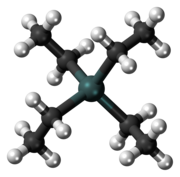Leaded petrol
 |
|
 |
|
| Names | |
|---|---|
|
IUPAC name
Tetraethylplumbane
|
|
| Other names
Lead tetraethyl
Tetraethyl lead |
|
| Identifiers | |
|
3D model (Jmol)
|
|
| Abbreviations | TEL |
| 3903146 | |
| ChEBI | |
| ChemSpider | |
| ECHA InfoCard | 100.000.979 |
| EC Number | 201-075-4 |
| 68951 | |
| MeSH | Tetraethyl+lead |
|
PubChem CID
|
|
| RTECS number | TP4550000 |
| UNII | |
| UN number | 1649 |
|
|
|
|
| Properties | |
| C8H20Pb | |
| Molar mass | 323.45 g·mol−1 |
| Appearance | Colorless liquid |
| Odor | pleasant, sweet |
| Density | 1.653 g cm−3 |
| Melting point | −136 °C (−213 °F; 137 K) |
| Boiling point | 84 to 85 °C (183 to 185 °F; 357 to 358 K) 15 mmHg |
| 0.00002% (20 °C) | |
| Vapor pressure | 0.2 mmHg (20 °C) |
|
Refractive index (nD)
|
1.5198 |
| Structure | |
| Tetrahedral | |
| 0 D | |
| Hazards | |
|
EU classification (DSD)
|
 
|
| R-phrases | R61, R26/27/28, R33, R50/53, R62 |
| S-phrases | S53, S45, S60, S61 |
| NFPA 704 | |
| Flash point | 73 °C (163 °F; 346 K) |
| Explosive limits | 1.8%–? |
| Lethal dose or concentration (LD, LC): | |
|
LD50 (median dose)
|
35 mg/kg (rat, oral) 17 mg/kg (rat, oral) 12.3 mg/kg (rat, oral) |
|
LDLo (lowest published)
|
30 mg/kg (rabbit, oral) 24 mg/kg (rat, oral) |
|
LC50 (median concentration)
|
850 mg/m3 (rat, 1 hr) |
|
LCLo (lowest published)
|
650 mg/m3 (mouse, 7 hr) |
| US health exposure limits (NIOSH): | |
|
PEL (Permissible)
|
TWA 0.075 mg/m3 [skin] |
|
REL (Recommended)
|
TWA 0.075 mg/m3 [skin] |
|
IDLH (Immediate danger)
|
40 mg/m3 (as Pb) |
| Related compounds | |
|
Related compounds
|
Tetraethylgermanium |
|
Except where otherwise noted, data are given for materials in their standard state (at 25 °C [77 °F], 100 kPa).
|
|
|
|
|
| Infobox references | |
Tetraethyl lead
Tetraethyllead (commonly styled tetraethyl lead), abbreviated TEL, is an organolead compound with the formula (CH3CH2)4Pb.
TEL was mixed with gasoline (petrol) beginning in the 1920s as a patented octane rating booster that allowed engine compression to be raised substantially, which in turn increased vehicle performance or fuel economy.Ethanol was already known as a widely available, inexpensive, low toxicity octane booster, but TEL was promoted because it was uniquely profitable to the patent holders. TEL in automotive fuel was phased out starting in the U.S. in the mid-1970s because of its cumulative neurotoxicity and its damaging effect on catalytic converters. When present in fuel, TEL is also the main cause of spark plug fouling. TEL is still used as an additive in some grades of aviation gasoline, and in some developing countries.
Innospec has claimed to be the last firm still making TEL, but as of 2013[update] TEL was apparently being produced illegally by several companies in China. As of June 2016 only Algeria, Yemen, and Iraq continue widespread use of leaded gasoline.
TEL is produced by reacting chloroethane with a sodium–lead alloy.
TEL is also produced by reacting Ethylmagnesium Iodide with lead(II) chloride.
...
Wikipedia

